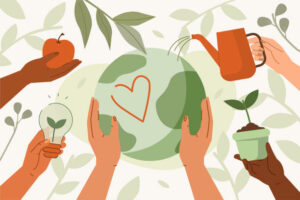Is Your Diet Sustainable?
Jana Faschinger-Sanborn (ECQA team) – 23rd of June 2022

When thinking of ways for one to be more sustainable on a day-to-day basis, most people think of activities such as switching old lightbulbs to LED ones, using public transportation where possible, switching out plastic straws with metal straws or bringing your own grocery bags to the store, as sufficient. While those are all steps into the right direction, we often miss or disregard the most obvious way to live more sustainably and decrease our own carbon footprint- our diet.
The way we produce, grow, ship and package food has a tremendous impact on the environment, especially when looking at the production of animal products.
As an example, to produce 1kg of beef, a total amount of 326,21 m2 of agricultural land is used 27kg of CO2, which is equivalent to driving about 100km. In comparison, the land usage and CO2 emissions of animal-free products such as potatoes (0,88m2/ kg and 9kg of CO2 or 11,2 km) or tofu (3,52m2 /kg and 2kg of CO2 or 7,2 km) are significantly less. With half of the world’s habitual land already being used for agricultural purposes and three-quarters of that being used to raise and feed livestock, it goes without saying that continuing with the way we have been eating is not sustainable and that we seriously need to rethink our dietary choices.
Hence, when we want to put effort into creating a more sustainable lifestyle for ourselves, we cannot and should not forget about what we put on our plates. Being more attentive towards what we eat and reducing our meat intake and incorporating meat-free (vegetarian) or even animal product-free (vegan) days/meals into our diet, is a huge step in the right direction and as we all are aware, every little step is better than no step at all.
Below you can find a calculator, that you can use to find out more about your foods/meals’ carbon footprint:
https://assets.plateupfortheplanet.org/carbon-calculator/
And for everyone, who would like to try out a plant-based meal at home, here is a quick recipe to get started:
Meat free Bolognese:
-(egg free) pasta of choice
-garlic
-1 onion finely chopped
-2 carrots finely chopped
-zucchini, mushrooms, or other vegetable of choice
-spices (oregano, basil, salt, pepper,…)
-red lentils or vegan ground beef alternative
-tomato sauce
-water (especially when using lentils)
-parmesan or parmesan alternative
⦁ Start with cutting all the veggies+ onion and add them to a pan and fry for a few minutes until you start smelling the carrots
⦁ Turn down the heat and add garlic (and vegan ground and cook until done – usually 3-5 mins)
⦁ Add tomato sauce + tomato paste- wash out the jar with a little water and add
⦁ add lentils- you will need to add additional water into the sauce, depending on how creamy you like it. Add ca. half a glass at a time and try the lentils once the sauce thickens and add more as needed)
⦁ Let the sauce simmer until lentils are done
⦁ If no lentils are used, the sauce is basically done as soon as the tomato sauce gets added, but its always a good idea to let it simmer for about 15 mins
Tips for the pasta:
⦁ The pasta shouldn’t be done before the sauce, so rather wait to cook the pasta while the sauce is basically done
⦁ Once done you can combine pasta+ sauce or add the sauce to your plate
Enjoy !
The recipe for the sauce can also be used for filling a lasagna!
Sources:
https://ourworldindata.org/land-use-diets
https://ourworldindata.org/grapher/land-use-per-kg-poore
https://www.bbc.com/news/explainers-59232599
